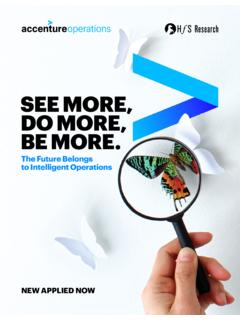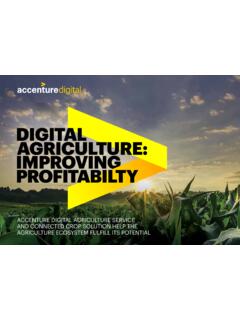Transcription of The long view of the chip shortage
1 1 The long view of the chip shortageBuilding resiliency in semiconductor supply chains2 Table of contentsExecutive summaryHit by a perfect stormStrengthening supply chain todayReimagining supply chain resilience for the future Every business is now a semiconductor business0304081117 The long view of the chip shortage3 The COVID-19 pandemic has impacted global industries of all kinds. However, few have felt greater supply chain pressures than semiconductor companies. Faced with a serious disruption in both supply and demand, semiconductor companies were forced to react with unforeseen speed to effectively manage their business and operations. As demand for chips continues to soar, supply chains will remain constrained for the foreseeable future . That means everyone semiconductor companies and those reliant on chips should build a more resilient supply chain.
2 Being better prepared for the future depends on re-examining near and long-term strategies, and acting on lessons learned from chip shortages that disrupted manufacturing for numerous valuable industries summaryThe long view of the chip shortage4 Hit by a perfect storm The chip shortage of 2021 sparked a crisis in the global economy. Apple, the world s largest buyer of chips, delayed the launch of the iPhone 12 by two months; Samsung, the second-largest buyer and also the second-largest producer will likely have to do the same for its new The global auto industry is expected to lose $ billion in revenue in The semiconductor shortage even caught the attention of US President Joe Biden who hosted a virtual summit with CEOs from affected So, what caused the shortage ?A perfect storm of skyrocketing chip demand, manufacturing capacity and logistics constraints.
3 4 The long view of the chip shortage5 Electronics demand goes into the stratosphereAs working and learning from home became the norm during COVID-19 and dollars went from going out for entertainment to streaming and gaming at home our behaviors fundamentally changed. This resulted in a booming demand for consumer Growing demand for devices in turn drove up demand for semiconductors. Every video game console, TV or tablet required numerous chips that were needed for display, power, connectivity and other lead timesStrong demand drove an imbalance in supply. For an industry that has long production lead times of ~18 weeks and where building additional capacity requires 6 to 9 months and billions of dollars of revenue, this meant supply recovery would be slow and Semiconductor Manufacturing Lead Time (weeks)Typical duration weeks1-2 Wafer FabricationAssemblyDistributionTe s tThe long view of the chip shortage5 Logistics constraints limit chip shipmentsTo make matters worse, chip shipments themselves were delayed due to the reduced amount of flights and closure of airways.
4 Additionally, global shipments of COVID-19 related items taking up capacity and the global grounding of dozens of B777 due to engine failures further put pressure on air cargo capacity. In total, global air cargo capacity declined a staggering 20% in on top of that, substrates the basis on which chip components and their connections are built were limited in supply due to a factory fire in Taiwan, which further impacted chip Year-over-year (2020 vs. 2019) monthly sales growth percentage change in automotive ICs20%15%10%0%-5%-5%-10%-15%-20%-25%JanF ebMarAprMayJunJulAugOctNovDecSource: World Semiconductor Trade Statistics Bluebook sales data 2020-20196 shortage strikes automakers first In the spring of 2020, automobile sales began to drop precipitously as showrooms closed their doors.
5 With a bleak outlook for the automotive industry due to the pandemic, companies forecasted a sustained drop in demand for their products and made decisions to reduce their demand for chips. This capacity was quickly claimed by the boom in electronics and other markets. But contrary to forecasts, vehicle sales rebounded incredibly fast, within just a few months, as a V-shaped recovery (see chart below). Imperfect inventory planning caused chip shortages and halted production. The problem is even if that 10-cent chip is missing, you can t sell your $30,000 car, said Gaurav Gupta, semiconductor analyst at long view of the chip shortage7 The new normal? Semiconductor companies have experienced supply disruptions before, such as the 2011 Fukushima earthquake, tsunami and subsequent nuclear disaster and flooding in Thailand later that this time is different.
6 The supply constraints and demand surges that caused the shortage are not one-off instances. The rising demand for electronics and the fierce competition for chips is not going away. The long view of the chip shortage8 Strengthening supply chains todayIt s imperative that semiconductor companies, as well as all companies that need chips for their products, take immediate action to build a more resilient supply chain for the future . These steps can help mitigate risk and minimize disruption to business and operations that can set the stage for short-term and long-term impact that requires greater investments in time and resources. 01020304 Know what chips you use, and where they come fromLearn current time to failure and time to recoveryStep into the supplier s shoesStrengthen your analytics control tower capabilitiesThe long view of the chip shortage90102 Surprisingly, organizations often do not have an exhaustive list of all chips that are in their products.
7 Instead, they often buy a functionality from suppliers, and do not have full access to a bill of materials or the buy items. But even when they do, organizations are challenged to reconstruct the supply route for those specific chips, as they would need to understand how their supplier s supplier or multi-tier supply base is set accurate map of the multi-tier supply chain will help to identify the trouble areas such as where there is risk exposure that needs to be This is critical if companies want to address existing shortages, and those they might encounter in the what chips you use, and where they come fromLearn current time to failure and time to recoveryAs part of understanding their current exposure, it s essential that companies also identify the impact disruptions would have in terms of time.
8 Together with MIT, Accenture co-developed a supply chain resilience stress test to assess operational and financial risks created by major market disruptions, including global chip The stress test starts with the creation of a digital twin of the organization s supply chain. This digital twin is then used to model various scenarios and their impact on the organization s ability to serve its ecosystem. The outcome of the test uncovers both the time it would take for a particular supply chain node to be restored to full functionality after a disruption (time to recovery), and the maximum duration the supply chain can match supply with demand after a disruption (time to survive).9 The long view of the chip shortage100310 Suppliers are often servicing multiple industries, each with their own terms of product margin, volume and stability.
9 Companies with their individuals terms need to ask themselves honestly: how attractive are you to constrained suppliers?Organizations should consider how to improve their position as a client. Some levers to pull that could improve attractiveness include their willingness to: Pay higher price and supplier margin Maximize volumes by aggregating demand and acting as one voice for your entiresupply chain (representing multiple tier-one suppliers in the negotiations) Expand volume commitmentsStep into the supplier s shoes04 Strengthen your analytics control tower capabilitiesCentralizing supply chain monitoring helps enable companies to gain insights into the severity of any problems that are occurring, such as limited capacity to meet demand. Leveraging analytics also helps predict what may lie ahead, such as a V-shaped recovery that would necessitate maintaining chip capacity or surging demand in other sectors.
10 Centralized monitoring can also put the spotlight on rising geo-political tensions that could lead to further disruption or pressure on an already constrained semiconductor supply chain, so that contingency plans or new strategies can be made capabilities are crucial to being able to proactively adjust manufacturing and/or order commitments to long view of the chip shortage11 Reimagining supply chain resilience for the futureLooking at long-term preparations, companies can build supply chain resilience into their planning and manufacturing processes by evaluating these key considerations: Know your supply competitors Rethinking supply networks and co-location Time's up for just-in-time11 Know your supply competitorsCompanies typically forecast for their customers based solely on their customers needs; that means a smartphone manufacturer will forecast for the chips they need based on demand for their that does make sense, the recent shortage has clearly highlighted the need for companies to look across the entire ecosystem and consider which other sectors they might have to compete with both from a demand and supply , companies look at competition in terms of who else is selling similar products to their customers.









